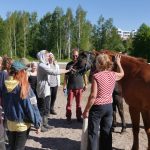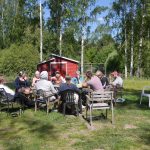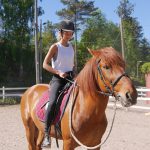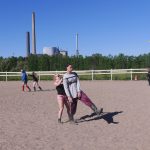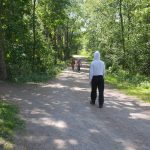Reading chapter 3 of Theatres of Immanence – Deleuze and the Ethics of Performance (2013) Laura Cull Ó Maoilearca, in preparation of todays Performance Philosophy Reading Group at the CPR – Center for Performance Research. The text has a very nice summary of Deleuze & Guattaris’ notes on animals, with a focus on the processes of becoming-animal and the art of butoh co-founder Hijikata Tatsumi and artist Marcus Coates. The author claims that “time-based arts of performance (and video) […] are particularly well suited to drawing our attention to the difference between human and nonhuman as a temporal one, as something to do with relative speed of perception and action”. I agree! When horses are conveyed trough a medium such as video they are flattened (abused). This abuse makes it more easy to identify how technologies that are perceived as neutral (such as cameras and roads) enforce human-centric world making (only humans fit in camera frames).
Humans and nonhuman animals are not ontologically different in kind […] rather they differ in terms of what their bodies can do, in terms of their affects, which includes the relationship their bodies have to duration. […] becoming-animal in performance involves embodying new ways of being in time and, in doing so, exploring how we might expand, extend or otherwise alter our human powers of perception and sensation alongside those of nonhuman animals.
The text offers a very short summary of “animals on stage” art-thinking, arguing that theatre is the last human venue were distinctions between humans and animals are played out. Animals on stage create a rupture from representation: The presence of live animals introduces a non or anti-intentional force (This applies in an interesting way to Mounted Police forces – The horses cannot be negotiated with, hence law is only enacted). The text also identifies that the stage as an apparatus attaches meaning (or the illusion of intention) to the animals presented on it.
According to Nakajima Natsu, a student of both Hijikata and [Kazuo] Ohno, Hijikata instited on the need for dancers to track down ‘all the signs of domestication of the body’, to locate their habitual ways of moving and to attempt to shed them like a dead skin. […] ‘Forms exist so that we can forget them’.
Butoh as an unlearning, body re-wilding process? An opposition to bodybuilding? Anyway… Butoh is not based on the notion of a sovereign author, nor does it assume the value of bodily control. Imitation might be necessary for becoming-animal but practitioners should believe that they can actually become animals.
‘You become animal only molecularly. You do not become a barking molar dog, but by barking, if it is done with enough feeling, with enough necessity and composition, you emit a molecular dog’. [Deleuze & Guattari]
Deleuze & Guattari use the term animal as a verb: “The wold is not fundamentally a characteristic or a certain number of characteristics; it is a wolfing”.
[…] the affects or powers of a body are not fixed for Deleuze; rather, they are constantly increasing and decreasing depending on to what extent the other bodies we encounter ‘agree’ or ‘disagree’ with us, to what extent they bring us ‘joy’ or ‘sadness’. What I can do is extended or expanded when I encounter a body that brings me joy […] ‘the affects of hoy are like a springboard that makes us pass trough something that we would never have been able to pass if there had only been sadness’ [Deleuze].
[…] affect has its own reality that comes prior to and produces affected bodies.
Can horses join these realities? Yes they can! When we act as their prosthetics in navigation (trough us horses have access to the internet). When we loose contact from each other, we cannot have access to the same reality again. If I die the horse will not miss me, it will brief for my death in a similar way I grief for something I’ve forgot. Something which I cant remember anymore.
Affect is not synonymous with human emotion, for Deleuze and Guattari; rather, it ‘crosses species boundaries that are normally ontologically policed’, passing between bodies of differing species and drawing them into ‘unnatural participation’ and ‘unholy alliances’.
Becoming is not product or goal oriented, constantly aiming to arrive at some imagined end-point; rather, Deleuze and Guattari insist that ‘becoming produces nothing other than itself’ or, again that ‘there is nothing outside of becoming to become’.
Focusing on speed (as an issue when forming relationships with animals) reminds me of Eyal Weizmans’ observation of highways of “walls of speed” which are intended to segregate citizens.
Different animals have different ways of being in time that produce what lies above and below their threshold of perception.
In the text this idea is explored further in relation to dynamic is discussed in relation to Marcus Coates Dawn Chorus (2007) video. During the production of the video they realised that when a birds song is slowed down, more notes can be identified (realtime 4-5 notes, slowed down up to 40 notes).
[…] the political dimensions of becoming-animal lie in its resistance to an ontological distinction, and therefore hierarchy between human and nonhuman animals. […] Two ways of performing this opening […] are to affirm the immanence of becoming to imitation; and to explore affects as a durational or temporal relation. […] Deleuze’s emphasis on affet invites us to break with the condescension of pity in favour of ‘unnatural partisipation’
I don’t think that anthropomorphism is bad. It is a form of imitation, a process of simulating other beings (in a human-sense-making matrix). It can be helpful for developing genuine localised knowledge of animals. For example rumours of a horses behaviour, explained in human-terms, passed forwards at a stable environment, may help us understand how to better work with a particular animal. Anthropomorphism also gives us important information on how we approach others: It helps us map out the specificities of our human-centric understanding and highlights our failures in developing an understanding of others (hiding it, will not change it).
Also, Timothy Morton argues that it’s telling how stigmatised anthropomorphism is: Perhaps it’s not permitted to sympathise with a pigs, because showing sympathy towards them would reveal their exploitation to be sadistic and cruel (But Humans are not bad, right? We’re only “misinformed”.) Jason Hribal argues that by retelling anthropomorphic stories, we can show the mechanism that build institutions which benefit from the humans/animal (and master/slave) divisions. For example: Disney stories illustrate our disgust to some species, only after this informations is outed we can affect it.
Side note: Humans can only slow down information (to make it understandable for themselves) but they cannot speed up their information intake – Humans always hear in “real time”#ॐ. If fast information streams are slowed down they can come understandable for humans (because data of the recoding becomes accessible to human sense-making and perception speeds), but slow messages will loose their data when they are speeded up (because the data is compressed and the resolution will be too high for human sense-making and perception). This means that humans cannot develop realities with beings, which make sense at a slower pace then they do. Even when they alter the speed in which signs of slower-then-human-sense-making-animals are experienced (ie. the speed of a recording of whale singing), they cannot make sense of what they hear slow enough. This means that human relationships to beings that reside in slower pace realities are noisy. To gain information from such realms, humans need to decrypt their experience, which is a slow and time consuming process. Humans must think fast to understand slow.


